

Do not use this type every time, as it will use more memory and therewith slow down your program. In case you are not sure what data type to use, the Variant type is the way to go. Most used data types are strings (words and sentences), integers (rounded numbers) and doubles (numbers with decimals). Just like when you would be moving and write down the contents of the box, it is needed to define the name of the variable and its data type. If you have never coded before, you could imagine a variable as a box to store information. Within the earlier defined macro, we start by adding a variable on line two. This should then open a new pane in the editor where you could start typing some code, as shown in Figure 01. Since I have been writing about VBA quite a bit lately, you could best follow the steps under the subtitle ‘How to Build a Macro with Visual Basic for Applications’ in this article.Īfter you have enabled the Developer tab in your ribbon, save your workbook as an Excel Macro Enabled Workbook (.xlsm), open the Visual Basic editor and double-click the ThisWorkbook option in the Project Explorer in the left-upper corner. Developer Tabīefore we start writing some code, it is important to enable the functionalities needed. Everyone should be able to follow this guide, even without any programming experience, though any prior coding experience will make certain concepts a lot easier to understand. Let me explain how!įor this tutorial we will be importing copyright free weather data of Amsterdam from the past, which you can find here. We could use this time to do more important things after we have automated this process using some simple VBA code.

This process of copy-pasting data might take an tremendous amount of time.

Often you will find yourself copy-pasting data from other files into a consolidated workbook to further investigate the data from there. Some functionalities of the application could only be utilised by using VBA, which then makes this older software even more helpful when analysing and manipulating data. Although launched in 1985, Excel is still extremely popular in most industries and is used by almost every company one way or another.


 0 kommentar(er)
0 kommentar(er)
